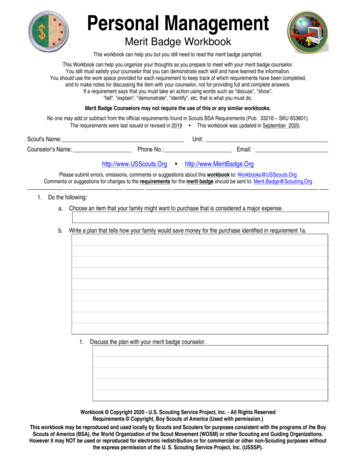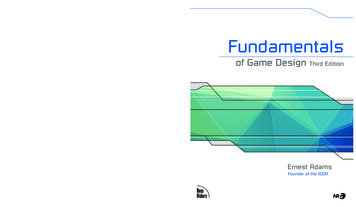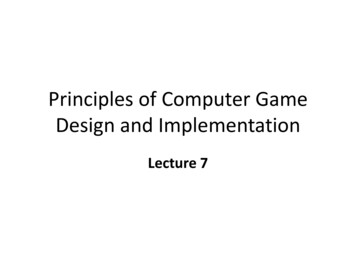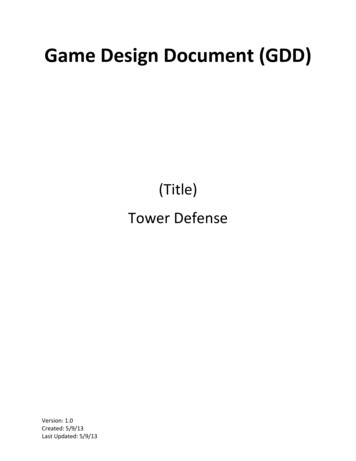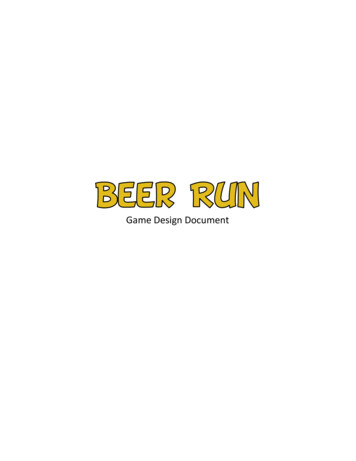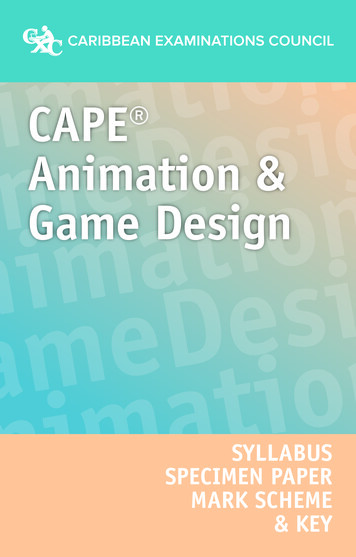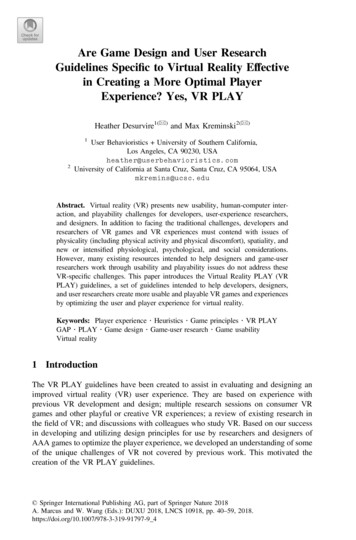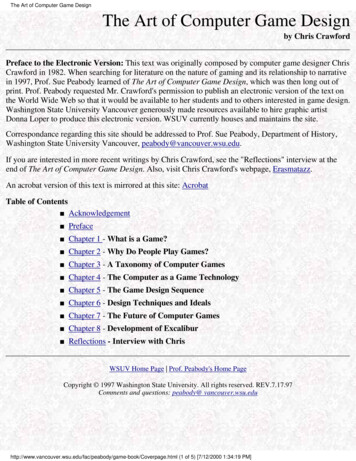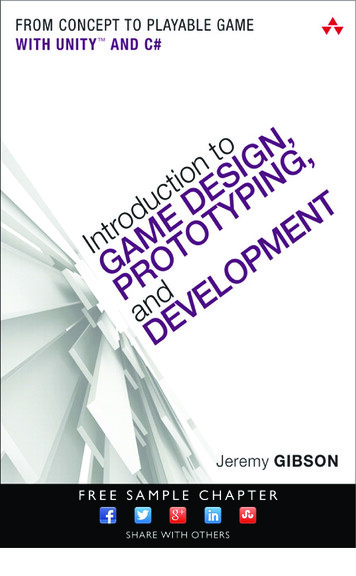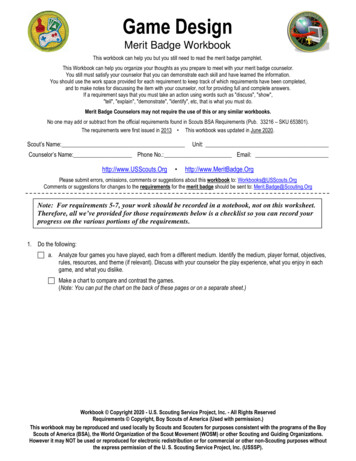
Transcription
Game DesignMerit Badge WorkbookThis workbook can help you but you still need to read the merit badge pamphlet.This Workbook can help you organize your thoughts as you prepare to meet with your merit badge counselor.You still must satisfy your counselor that you can demonstrate each skill and have learned the information.You should use the work space provided for each requirement to keep track of which requirements have been completed,and to make notes for discussing the item with your counselor, not for providing full and complete answers.If a requirement says that you must take an action using words such as "discuss", "show","tell", "explain", "demonstrate", "identify", etc, that is what you must do.Merit Badge Counselors may not require the use of this or any similar workbooks.No one may add or subtract from the official requirements found in Scouts BSA Requirements (Pub. 33216 – SKU 653801).The requirements were first issued in 2013 This workbook was updated in June 2020.Scout’s Name:Unit:Counselor’s Name: Phone No.: Email:http://www.USScouts.Org http://www.MeritBadge.OrgPlease submit errors, omissions, comments or suggestions about this workbook to: Workbooks@USScouts.OrgComments or suggestions for changes to the requirements for the merit badge should be sent to: Merit.Badge@Scouting.OrgNote: For requirements 5-7, your work should be recorded in a notebook, not on this worksheet.Therefore, all we’ve provided for those requirements below is a checklist so you can record yourprogress on the various portions of the requirements.1. Do the following: a. Analyze four games you have played, each from a different medium. Identify the medium, player format, objectives,rules, resources, and theme (if relevant). Discuss with your counselor the play experience, what you enjoy in eachgame, and what you dislike. Make a chart to compare and contrast the games.(Note: You can put the chart on the back of these pages or on a separate sheet.)Workbook Copyright 2020 - U.S. Scouting Service Project, Inc. - All Rights ReservedRequirements Copyright, Boy Scouts of America (Used with permission.)This workbook may be reproduced and used locally by Scouts and Scouters for purposes consistent with the programs of the BoyScouts of America (BSA), the World Organization of the Scout Movement (WOSM) or other Scouting and Guiding Organizations.However it may NOT be used or reproduced for electronic redistribution or for commercial or other non-Scouting purposes withoutthe express permission of the U. S. Scouting Service Project, Inc. (USSSP).
Game DesignScout's Name:Game 1MediumPlayer FormatObjectivesRulesResourcesThemeDiscuss the play experience, what you enjoy and what you dislike.Game Design - Merit Badge WorkbookPage. 2 of 15
Game DesignScout's Name:Game2MediumPlayer FormatObjectivesRulesResourcesThemeDiscuss the play experience, what you enjoy and what you dislike.Game Design - Merit Badge WorkbookPage. 3 of 15
Game DesignScout's Name:Game 3MediumPlayer FormatObjectivesRulesResourcesThemeDiscuss the play experience, what you enjoy and what you dislike.Game Design - Merit Badge WorkbookPage. 4 of 15
Game DesignScout's Name:Game 4MediumPlayer FormatObjectivesRulesResourcesThemeDiscuss the play experience, what you enjoy and what you dislike.Game Design - Merit Badge WorkbookPage. 5 of 15
Game DesignScout's Name:b. Describe four types of play value and provide an example of a game built around each concept.Type of Play ValueExample12.3.4.Discuss other reasons people play games.2. Discuss with your counselor five of the following 17 game design terms. For each term that you pick, describe how it relatesto a specific game.Thematic game elements: story, setting, charactersGame Design - Merit Badge WorkbookPage. 6 of 15
Game DesignScout's Name:Gameplay elements: play sequence, level design, interface designGame analysis: difficulty, balance, depth,Game Design - Merit Badge WorkbookPage. 7 of 15
Game DesignScout's Name: pace, replay value, age appropriatenessRelated terms: single-player vs. multiplayer, cooperative vs. competitive, turn-based vs. real-time,Game Design - Merit Badge WorkbookPage. 8 of 15
Game DesignScout's Name: strategy vs. reflex vs. chance, abstract vs. thematic3. Define the term intellectual property.Describe the types of intellectual property associated with the game design industry.Describe how intellectual property is protected and why protection is necessary.Define and give an example of a licensed property.Game Design - Merit Badge WorkbookPage. 9 of 15
Game DesignScout's Name:4. Do the following: a. Pick a game where the players can change the rules or objectives (examples: basketball, hearts, chess, kickball).Game:Briefly summarize the standard rules and objectives and play through the game normally. b. Propose changes to several rules or objectives.Predict how each change will affect gameplay. c. Play the game with one rule or objective change, observing how the players’ actions and emotional experiences areaffected by the rule change.Rule Change:Observations: Repeat this process with two other changes.Game Design - Merit Badge WorkbookPage. 10 of 15
Game DesignScout's Name:Rule Change 2:Observations:Rule Change 3:Observations: b. Explain to your counselor how the changes affected the actions and experience of the players.Discuss the accuracy of your predictions.5. Design a new game. Any game medium or combination of mediums is acceptable. Record your work in a game designnotebook. a. Write a vision statement for your game. Identify the medium, player format, objectives, and theme of the game. If suitable, describe the setting, story, andcharacters. b. Describe the play value. c. Make a preliminary list of the rules of the game. Define the resources. d. Draw the game elements.Game Design - Merit Badge WorkbookPage. 11 of 15
Game DesignScout's Name:6. Do the following: a. Prototype your game from requirement 5. If applicable, demonstrate to your counselor that you have addressedplayer safety through the rules and equipment. Record your work in your game design notebook.You must have your merit badge counselor’s approval of your concept before you begin creating theprototype. b. Test your prototype with as many other people as you need to meet the player format. Compare the play experience to your descriptions from requirement 5b. Correct unclear rules, holes in the rules, dead ends, and obvious rule exploits. Change at least one rule, mechanic, or objective from your first version of the game, and describe why you aremaking the change. Play the game again. Record in your game design notebook whether or not your change had the expected effect. c. Repeat 6b at least two more times and record the results in your game design notebook.First repetition: Test your prototype with as many other people as you need to meet the player format. Compare the play experience to your descriptions from requirement 5b. Correct unclear rules, holes in the rules, dead ends, and obvious rule exploits. Change at least one rule, mechanic, or objective from your first version of the game, and describe why you aremaking the change. Play the game again. Record whether or not your change had the expected effect.Second repetition: Test your prototype with as many other people as you need to meet the player format. Compare the play experience to your descriptions from requirement 5b. Correct unclear rules, holes in the rules, dead ends, and obvious rule exploits. Change at least one rule, mechanic, or objective from your first version of the game, and describe why you aremaking the change. Play the game again. Record whether or not your change had the expected effect.7. Blind test your game. Do the following: a. Write an instruction sheet that includes all of the information needed to play the game. Clearly describe how to set up the game, play the game, and end the game. List the game objectives. b. Share your prototype from requirement 6a with a group of players that has not played it or witnessed a previousplaytest. Provide them with your instruction sheet(s) and any physical components. Watch them play the game, but do not provide them with instruction. Record their feedback in your game design notebook. c. Share your game design notebook with your counselor.Game Design - Merit Badge WorkbookPage. 12 of 15
Game DesignScout's Name: Discuss the player reactions to your project and what you learned about the game design process. Based on your testing, determine what you like most about your game and suggest one or more changes.8. Do ONE of the following: a. With your parent’s permission and your counselor’s approval, visit with a professional in the game developmentindustry and ask him or her about his or her job and how it fits into the overall development process. Alternately,meet with a professional in game development education and discuss the skills he or she emphasizes in theclassroom.Game Design - Merit Badge WorkbookPage. 13 of 15
Game DesignScout's Name: b. List three career opportunities in game development1.2.3.Pick one and find out the education, training, and experience required for this scuss this with your counselor. Explain why this profession might interest youWhen working on merit badges, Scouts and Scouters should be aware of some vital information in the current edition ofthe Guide to Advancement (BSA publication 33088). Important excerpts from that publication can be downloaded meritbadges.pdf.You can download a complete copy of the Guide to Advancement from me Design - Merit Badge WorkbookPage. 14 of 15
Note to the Counselor:The project portion of the Game Design merit badge gives Scouts flexibility to work with a medium of their choosing.The level of effort required to make a game in different mediums can vary significantly. However, the requirementsdefine what each Scout must include in his design notebook so that there is a baseline for all Scouts to meet.The notebook must demonstrate a thoughtful initial concept, multiple design iterations based on initial testing, andfeedback from blind testing. Encourage Scouts to use their notebook to record brainstorming sessions, testparameters, and any game-related ideas throughout the process. Also encourage them to record thoughts behind keydesign decisions to help them trace and retrace their steps as their designs evolve.Before a Scout begins the prototyping phase, he must have counselor approval for his design concept. The counselormust make sure that he has put enough effort into the concept phase to have a good foundation for the prototypephase. Watch out for overly ambitious projects that could lead to unnecessary frustration. It is important to understandthat the Scout is making a prototype. The challenge of the project is to develop and experiment with gameplay, not todevelop extensive programming skills, create beautiful artwork, or spend a lot of time fabricating components.When prototyping, Scouts should devote most of their energy to assessing and improving the play experience. Witheach iteration, Scouts should identify game elements that they want to change and how the changes will alter the playexperience. After making changes, they then test the game and evaluate whether or not the changes had the desiredoutcome. It is acceptable for the final prototype to be very different from the initial concept, provided that the notebookshows the progression.Because the project is so flexible, it is likely that you will have Scouts working in mediums with which you areunfamiliar. The game design community has a vast array of publicly available resources, and the merit badgeinformation online at www.scouting.org maintains updated links to relevant material. If you have a specific concernabout programming an electronic game prototype, there are a number of free or inexpensive game design softwarepackages available online. Some are very easy to use with little or no computer knowledge, and most have robustinformation resources to support them. See the resources section at the end of (the) pamphlet.The merit badge includes many opportunities for teamwork and group play. Group participation is mandatory tocomplete requirement 7, but all of the other nonproject requirements also work well in collaboration. Note, though, thateach Scout must deliver his own game prototype to complete the project. This ensures that every Scout has thechance to develop and use the critical thinking skills that are part of testing and design iteration. If they want tocollaborate on their projects after completing the requirements for the badge they are encouraged to do so, but that isbeyond the scope of this badge.The Game Design merit badge relies heavily on specific terminology. Because game design is broad and gameanalysis is relatively young, there are few established definitions in the industry. Please refer to the glossary at the endof (the) pamphlet for definitions applicable to the pamphlet and requirements. For additional questions, refer to themerit badge website and the resources listed at the end of the pamphlet.Page. 15 of 15
Important excerpts from the Guide To Advancement - 2015, No. 33088 (SKU-620573)[1.0.0.0] — IntroductionThe current edition of the Guide to Advancement is the official source for administering advancement in all Boy Scouts of America programs: Cub Scouting, BoyScouting, Varsity Scouting, Venturing, and Sea Scouts. It replaces any previous BSA advancement manuals and previous editions of the Guide to Advancement.[Page 2, and 5.0.1.4] — Policy on Unauthorized Changes to Advancement ProgramNo council, committee, district, unit, or individual has the authority to add to, or subtract from, ad
Game Design Scout's Name: _ Game Design - Merit Badge Workbook Page. 13 of 15 Discuss the player reactions to your project and what you learned about the game design process. Based on your testing, determine what you like most about your game and suggest one or more changes. 8. Do ONE of the following: a. With your parent’s permission and your counselor’s approval, visit with a .


